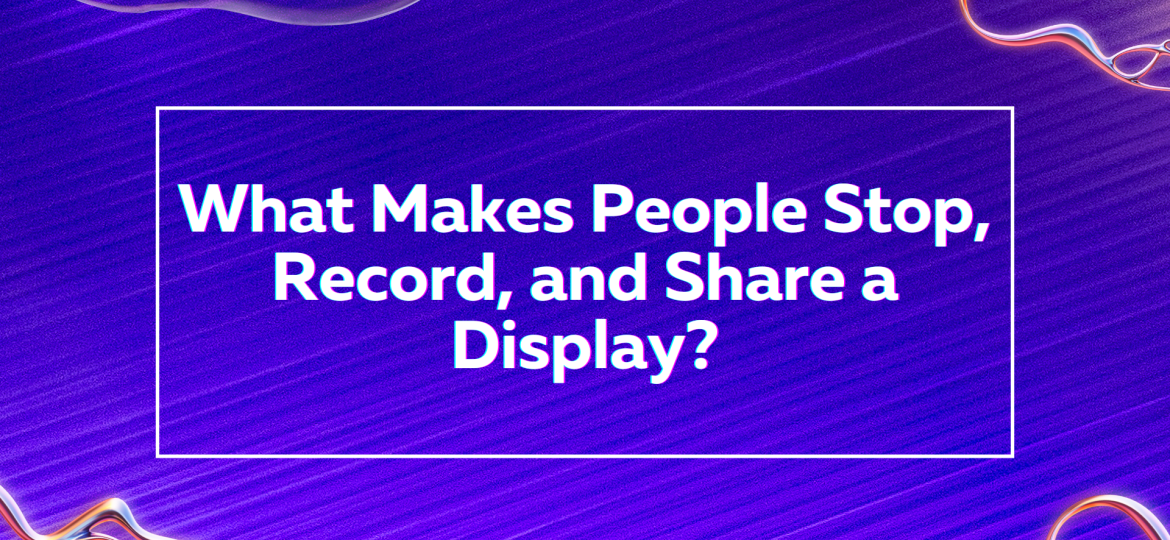What Makes People Stop, Record, and Share a Display?
What Makes People Stop, Record, and Share a Display?
In the oversaturated marketing environment, getting someone to stop and look at your display is an achievement. Getting them to pull out their phone, record it, and share it with others? That’s viral-level marketing success.
But this doesn’t happen by chance. Whether you’re a retailer, event organizer, or brand marketer, understanding why people engage with certain displays. and ignore others, is key to creating share-worthy campaigns that fuel both foot traffic and online reach.
So, what’s the secret to designing displays that spark that “Wow, I need to film this” reaction?
Let’s break it down.
1. Novelty: The First Hook
People stop for what they haven’t seen before. A display that challenges visual expectations or offers an unexpected twist immediately interrupts auto-pilot behavior. Whether it’s a kinetic sculpture, a light illusion, or a floating object in mid-air, novelty is the fastest way to earn attention.
Think of it this way: if your audience walks past five clothing stores with mannequins and minimal signage, your rotating, color-shifting, or interactive visual suddenly becomes a magnet.
In short, if you want someone to stop and record, you have to show them something worth remembering.
2. Motion & Sound: Multi-Sensory Triggers
Static displays rarely create share-worthy moments on their own. Humans are hardwired to notice movement and sound, which is a survival behavior repurposed for modern advertising.
- Motion: Rotating elements, slow reveals, or animated projections help guide the eye.
- Sound: Subtle audio cues, such as ambient music, whispers, or triggered sound effects, create immersion and curiosity.
When done well, the combination of visual movement and sound not only grabs attention but also makes people feel like they’ve “discovered” something. And discovery is a powerful motivator to record and share.
3. Emotion Over Information
Too many displays lead with product specs or pricing. That’s not what gets people recording.
Displays that evoke emotion of joy, nostalgia, surprise, awe stick with us longer. Whether it’s a heartwarming scene, a jaw-dropping illusion, or an amusing twist, emotions drive action.
The next time you plan a display, ask: What emotion will this spark within five seconds? If the answer is none, it won’t be shareable.
4. Built-In Interaction
People are far more likely to record and share content they had a hand in creating.
- Can the display respond to movement?
- Does it let someone “unlock” a reveal?
- Can viewers see themselves reflected or projected into the experience?
When a display involves its viewer in real time, even in simple ways, it turns passive attention into active participation. This is when phones come out.
5. Shareability by Design
Great displays don’t just look good in person. They’re also optimized for the lens of a phone camera.
That means:
- Strong lighting and contrast (no blown-out whites or dim grays)
- Clean visual focal points
- A clear, short story that can be captured in under 10 seconds
- Elements that loop or reset predictably for easy filming
If your display only works when viewed from a specific angle or if it’s too subtle for the camera to pick up, it won’t go far online.
6. Social Proof Loop
People don’t want to miss out. If they see others stopping, filming, or reacting, they’ll likely do the same. That’s why the best displays include built-in prompts that encourage interaction and sharing:
- Subtle signage like “#SeenAtUnionStation” or “Tag us @CreativBuzz”
- QR codes that reveal augmented layers when scanned
- Time-based activations (“Watch what happens at the top of every hour”)
When people see others engaged, their curiosity and camera follow.
7. The Power of 3D Holographic Displays
All the above strategies become exponentially more powerful when paired with 3D holographic visuals. These displays combine motion, light, and illusion in a way that feels futuristic and rare, two ingredients that nearly guarantee attention and recording.
At Creativ Buzz, we’ve seen brands multiply foot traffic and online visibility simply by swapping static banners with floating 3D content. It’s more than a gimmick—it’s an evolution in display marketing that makes people stop, record, and share instinctively.
If you’re looking for a high-impact solution that breaks through visual noise and converts attention into engagement, 3D holographic advertising is the edge your brand needs.
Conclusion
People don’t stop and film a display because you asked them to. They do it because something made them feel, react, or see something they hadn’t seen before.
By combining novelty, motion, emotional appeal, and interactivity, with the right tech behind it—you can design a display that doesn’t just fill space, but fills camera rolls and social feeds.
Want to turn your next campaign into a shareable moment? Reach Creativ Buzz can help you craft immersive, visually arresting displays that people want to stop for.




